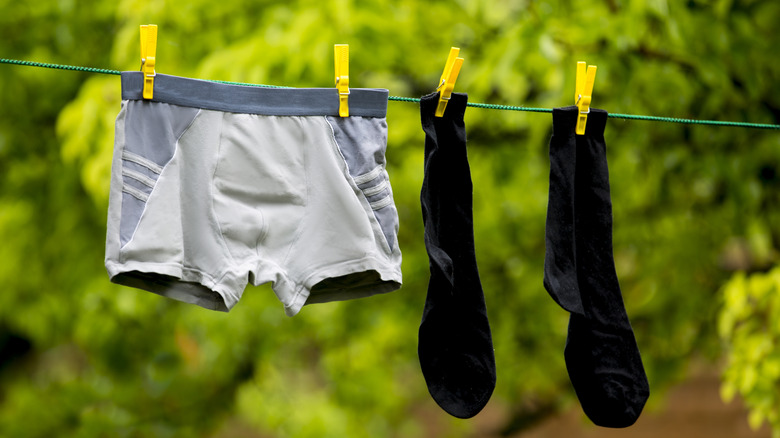The Worst Type Of Underwear To Sport When Hiking
When getting ready for a hike, most people spend their time thinking about the external layers such as what jacket to bring and which backpack to choose. However, just like choosing the right external gear is important, choosing the correct internal clothing can make a big difference in whether or not your hike is a fun adventure or an uncomfortable experience. This is true for all of your base layers, but especially for the most basic of the base layers — your underwear. When it comes to bad underwear to wear on a hike, cotton underwear takes the number one spot for the worst choice.
The reason for this is that while the natural fibers of cotton make cotton undies comfortable and breathable in most situations, cotton is also a fabric that tends to retain moisture. This means that when participating in physical activities where you will sweat, cotton underwear has the unfortunate quality of staying wetter for longer. This will lead to general discomfort, unpleasant odors, and even chafing — a hiker's worst nightmare.
So, if you are supposed to avoid cotton while hiking, what material should you choose instead?
Synthetic fabrics or Merino wool
When it comes to hiking base layers — including underwear — the most commonly recommended options are either those made from synthetic materials like polyester and nylon or Merino wool. Merino wool has taken the trekking world by storm over the last few years and for good reason. This wool is not only breathable and moisture-wicking but is also soft without being itchy or irritating like traditional wool. On top of this, Merino wool has anti-microbial properties which make it naturally odor-resistant, perfect for thru-hiking and backpacking.
However, Merino wool does have a few downsides. The first is that it can be expensive. Furthermore, while this wool is odor-resistant, it will get smelly eventually, and the more you sweat, the faster it will stink. Wool underwear also doesn't dry out as quickly as those made from synthetic materials.
So, if you will be hiking in a warm climate, you may want to go with underwear made from a synthetic material instead. Synthetic materials like polyester and nylon are not only quick-dry but are also great at wicking away moisture to keep you feeling dry and comfortable. The main downside of underwear made of synthetic fabrics is that they tend to hold onto odor more than wool.
How to choose a style and cut
Once you choose your preferred material, you can start thinking about the style and cut of underwear that is right for you. A lot of this comes down to personal preference but, in general, a good pair of hiking underwear should be tight-fitting to prevent unnecessary bunching but not so tight as to be uncomfortable. Furthermore, if you are prone to chaffing, you may want to avoid underwear with thick seams as these seams are more likely to rub against your skin and cause irritation as you move. You may also want to consider removing the tags or purchasing tagless undies so that you won't have that piece of scratchy fabric rubbing against your lower back the entire journey.
Overall, when choosing hiking underwear, you should go with a style that has worked for you in the past during other kinds of physical activity. On top of this, it's always a good idea to hit a trail to test out a pair of new underwear to see if they're right for you before committing to a seven-day thru-hike with your new and untested pair of hiking briefs.


